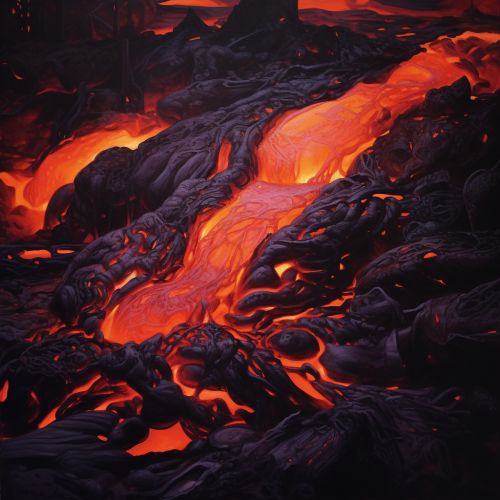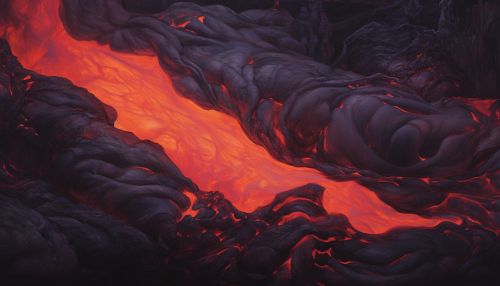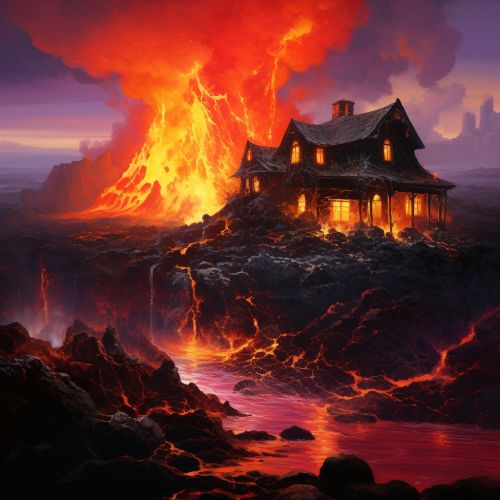Lava
Introduction
Lava is a molten rock expelled by a volcano during an eruption. This molten rock is formed when the mantle layer under the Earth's crust melts. When this molten rock reaches the surface of the Earth, it is called lava. Depending on its viscosity and gas content, lava can flow slowly or rapidly, and it can form different types of landforms when it cools and solidifies.


Formation
Lava is formed in the mantle of the Earth, which is located beneath the Earth's crust. The mantle is composed of silicate rock rich in minerals such as magnesium and iron. When these minerals are subjected to high temperatures and pressures, they melt to form magma. The process of magma formation is known as partial melting.
The magma rises through the Earth's crust due to its lower density compared to the surrounding rock. This ascent can occur at tectonic plate boundaries, where the Earth's crust is being pulled apart or pushed together, or at hotspots, which are areas of intense heat in the mantle. When the magma reaches the surface of the Earth, it is called lava.
Types of Lava
There are two main types of lava: mafic and felsic.
Mafic Lava
Mafic lava, also known as basaltic lava, is rich in iron and magnesium and has a low silica content. This type of lava is characterized by its high temperature (up to 1200°C) and low viscosity, which allows it to flow easily and quickly. Mafic lava is commonly found at mid-ocean ridges and hotspots, such as the Hawaiian Islands.
Felsic Lava
Felsic lava, also known as rhyolitic or dacitic lava, is rich in silica and has a low iron and magnesium content. This type of lava is characterized by its lower temperature (800-1000°C) and high viscosity, which makes it flow slowly and tends to cause explosive eruptions. Felsic lava is commonly found at continental volcanic arcs, such as the Andes.
Lava Flows
Lava flows are streams of molten rock that pour or ooze from an erupting vent. The behavior of a lava flow is determined by its viscosity, which is influenced by its temperature, composition, and crystal and gas content.


Pahoehoe
Pahoehoe is a type of mafic lava flow that is characterized by a smooth, billowy, or ropy surface. It is relatively low in viscosity and can flow quickly and for long distances. Pahoehoe flows are common in Hawaiian-type eruptions.
Aa
Aa is another type of mafic lava flow that is characterized by a rough, jagged, and blocky surface. It is higher in viscosity than pahoehoe and tends to move in a series of small avalanches. Aa flows are common in both Hawaiian and Strombolian-type eruptions.
Block Lava
Block lava flows are a type of felsic lava flow that is characterized by a surface of angular blocks. They are high in viscosity and move slowly, often forming thick, short flows.
Dome Lava
Dome lava flows are another type of felsic lava flow that is characterized by the formation of large, bulbous mounds of lava called lava domes. They are very high in viscosity and move extremely slowly, often causing the lava to pile up around the vent.
Lava Landforms
Lava can create a variety of landforms when it cools and solidifies. These include lava flows, lava domes, lava tubes, lava lakes, and volcanic cones.
Lava Flows
Lava flows are the most common type of lava landform. They can range in thickness from a few centimeters to several meters, and they can cover large areas. Lava flows can create a variety of surface features, including pahoehoe and aa surfaces, as well as lava channels and lava levees.
Lava Domes
Lava domes are formed when highly viscous lava is extruded from a volcanic vent and piles up around the vent. They can be up to several hundred meters high and several kilometers in diameter.
Lava Tubes
Lava tubes are formed when the surface of a lava flow cools and solidifies while the interior remains liquid and continues to flow. When the lava eventually drains away, it leaves behind a hollow tube.
Lava Lakes
Lava lakes are large volumes of molten lava contained within a volcanic vent or crater. They are relatively rare and are usually associated with effusive eruptions.
Volcanic Cones
Volcanic cones are hills or mountains formed by the accumulation of lava and other volcanic materials around a vent. There are several types of volcanic cones, including cinder cones, composite cones, and shield volcanes.
Hazards
Lava flows pose a variety of hazards to humans and the environment. These include destruction of property, alteration of landscapes, and emission of hazardous gases.


Destruction of Property
Lava flows can destroy anything in their path, including homes, roads, and other infrastructure. The speed and direction of a lava flow can be influenced by the topography of the land, but it is generally difficult to predict or control.
Alteration of Landscapes
Lava flows can significantly alter landscapes by covering existing features and creating new ones. This can lead to changes in drainage patterns and loss of fertile soil.
Emission of Hazardous Gases
Lava flows can emit a variety of hazardous gases, including sulfur dioxide, carbon dioxide, and hydrogen sulfide. These gases can cause respiratory problems and other health issues in humans and animals, and they can also contribute to climate change.
